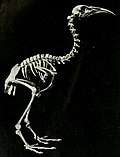Hawkins's rail
Hawkins' rail or the giant Chatham Island rail, Diaphorapteryx hawkinsi, was a flightless extinct bird endemic to the Chatham Islands south of New Zealand. It is known to have existed only on the main islands of Chatham Island and Pitt Island. It is largely known from skeletal remains found in the kitchen middens of the original Polynesian inhabitants, the Moriori.
| Hawkins's rail | |
|---|---|
_601694.jpg) | |
| Skeleton from the collection of Auckland Museum | |
| Scientific classification | |
| Kingdom: | Animalia |
| Phylum: | Chordata |
| Class: | Aves |
| Order: | Gruiformes |
| Family: | Rallidae |
| Genus: | †Diaphorapteryx Forbes, 1893 |
| Species: | †D. hawkinsi |
| Binomial name | |
| †Diaphorapteryx hawkinsi (Forbes, 1892) | |
The bird was approximately 16 inches (410 mm) tall and weighed about 4.5 pounds (2.0 kg) and is thought to have been primarily an insectivore.
_601712_(cropped).jpg)
Henry Ogg Forbes originally placed the bird in the same genus as the red rail of Mauritius, Aphanapteryx, but later moved it to its own genus.[2][3] A 2014 genetic study found that it formed a clade with the Invisible rail of Indonesia with a common origin around 10 million years ago, as the sister clade to the Gallirallus radiation.[4]
It was long thought that the Hawkins' rail was extinct prior to European discovery, however recent evidence suggests that the bird may have become extinct much later. An 1895 letter from Sigvard Dannefaerd belonging to financier/zoologist Walter Rothschild describes the appearance, behaviour, and Moriori hunting method concerning the species. A second account was published by Alexander Shand in 1911, though he seems to confuse the bird with a large parrot. The accounts suggest that the bird was known as the Mehonui and was dull brick-red in colour, that it spent much ot its time pecking for invertebrates in decayed wood, similar in lifestyle to the Weka. Its cry was described a loud "Tue-ck" sound. Groups of five to eight individuals likely formed during the breeding season. Due to the strength of its beak it has been suggested to have preyed on ground dwelling chicks, including those of petrels.[5]
Photo Gallery
 Skeleton of Hawkins' rail (Diaphorapteryx hawkinsi)
Skeleton of Hawkins' rail (Diaphorapteryx hawkinsi)_601702.jpg) Fossil bones from the collection of Auckland Museum
Fossil bones from the collection of Auckland Museum_601710.jpg) Leg and foot bones from the collection of Auckland Museum
Leg and foot bones from the collection of Auckland Museum_601698.jpg) Skeleton from the collection of Auckland Museum
Skeleton from the collection of Auckland Museum Skull bones
Skull bones
References
- BirdLife International (2012). "Diaphorapteryx hawkinsi". IUCN Red List of Threatened Species. 2012. Retrieved 26 November 2013.CS1 maint: ref=harv (link)
- FORBES, H- O. (1892). "New Extinct Rail". Nature. 45 (1166): 416. doi:10.1038/045416d0.
- FORBES, H. O. (1893). "Mr. H. O. Forbes's Discoveries in the Chatham Islands". Nature. 48 (1232): 126. doi:10.1038/048126a0.
- Garcia-R, Juan C.; Gibb, Gillian C.; Trewick, Steve A. (December 2014). "Deep global evolutionary radiation in birds: Diversification and trait evolution in the cosmopolitan bird family Rallidae". Molecular Phylogenetics and Evolution. 81: 96–108. doi:10.1016/j.ympev.2014.09.008. ISSN 1055-7903.
- COOPER, JOANNE H; TENNYSON, ALAN J. D. (2004). "New evidence on the life and death of Hawkins' rail (Diaphorapteryx hawkinsi): Moriori accounts recorded by Sigvard Dannefaerd and Alexander Shand" (PDF). Notornis. 51: 212–216.
